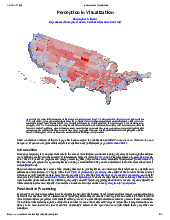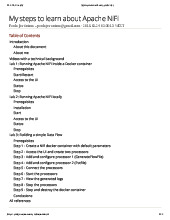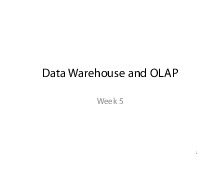



















Preview text:
Chapter 1 Introduction to data governance !"#$%&'()* &'+) 2 Data governance is becoming more important 3 How big is big data? 4 5
Advanced Data Col ection in Sports 6
More Kinds of Data (Including More Sensitive Data) Are Now Being Col ected
• One digital interaction every eighteen seconds 7 How big is big data? 8
Data science: The 4th paradigm for scientific discovery 9 Big data in 2008 10 Big data sources • E-commerce • Social networks • Internet of things
• Data-intensive experiments (bioinformatics, quantum physics, etc) 11 Data is the new oil 12 Big data 5'V
Big data is a term for data sets that are so large or complex that
traditional data processing application software is inadequate to deal with them (wikipedia) 13 Data value
• Data is the most valuable
asset in an organisation
after its people
• Data is critical to the
running of business
functions and processes
• Data need constant
vigilance and effort to
maintain data quality Source: sciphilos.info 14 Big data – big value source: wipro.com 15 Other facts
• The Number of People Working and/or Viewing the Data Has Grown Exponential y
• A report by Indeed shows that the demand for data science jobs
had jumped 78% between 2015 and 2018.
• IDC also reports that there are now over five billion people in the
world interacting with data, and it projects this number to
increase to six billion (nearly 75% of the world’s population) in 2025.
• Companies are obsessed with being able to make “data-driven decisions,”
• New Regulations and Laws Around the Treatment of Data
• EU’s General Data Protection Regulation (GDPR) regulates data,
data collection, data access, and data use.
• Ethical Concerns Around the Use of Data
• 2018. a man was struck and killed by a self-driving car. Who was responsible?
• 2014, Amazon developed a recruiting tool, however, it was found
that the tool discriminated against women. 16 Introduction to data governance 17 Data governance
• Data governance is a collection of processes,
roles, policies, standards, and metrics that ensure
the effective and efficient use of information
• for the end-to-end lifecycle of data (collection, storage, use,
protection, archiving, and deletion). The 5-second elevator • a set of guidelines definition Data for how people governa behave and make nce is … decisions about data 18
Important characteristics of DG Data governance IS Data Governance IS NOT • More about people and • IT’s responsibility behavior than data • Solved by technology
• A system that requires and promotes shared agreement
• Equally applied across all data assets • Formal (i.e. written down) • Adds value by supporting institutional mission/goals 20
Data governance vs. data management
• Data management is the technical implementation of data governance.
• Data governance without implementation is just documentation.
• Enterprise data management enables the execution and
enforcement of policies and processes.
• Data management refers to the management of the full
data lifecycle needs of an organization.
• Cleansing and standardization
• Masking and encryption
• Archiving and deletion 21




